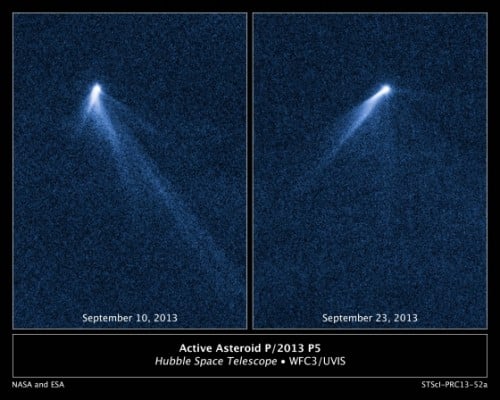The tails were most likely formed in a series of large dust eruption events." At least this is evidenced by models compiled by team member Jessica Aggarwal from the Max Planck Institute for the Solar System in Lindau, Germany.

Astronomers have discovered the strangest object in the solar system - an asteroid that resembles a spinning target. The asteroid orbits the Sun in the main asteroid belt between Mars and Jupiter. The finding was published on November 7 in the Astrophysical Journal Letters.
Ordinary asteroids appear simply as cautious points of light. This strange asteroid has six comet-like dust tails protruding from it like the arms of a vane.
"It's hard to believe we're watching an asteroid," said lead researcher David Jewitt, a professor in UCLA's Department of Earth and Space Sciences and the same university's Department of Physics and Astronomy. "Surprisingly, the structure of the tail changed dramatically within 13 days as the asteroid spewed dust."
One explanation is that the asteroid's rotation rate increased to the point where the surface began to disintegrate, spewing dust in sudden bursts that began about six months ago. The team ruled out another asteroid hitting the same asteroid due to the large amount of dust that flew into space at the same time. This object, named P/2013 P5, emitted dust for at least five months," he said.
The asteroid was first observed as a nebulous object by the Panstars automated telescope in Hawaii. Its many tails were discovered in an image taken by the Hubble Space Telescope on September 10, 2013. When Hubble returned to the asteroid on September 23, its appearance changed. The whole building seemed to start spinning. "We were really shocked," said Jewitt.
The tails were most likely formed in a series of large dust eruption events." At least this is evidenced by models compiled by team member Jessica Aggarwal from the Max Planck Institute for the Solar System in Lindau, Germany. Aggarwal calculated that the first emission occurred on April 15 and the last on September 4. In between, the asteroid erupted on July 18, July 24, August 8 and August 26.
In the same topic on the science website:
"The radiation pressure from the sun blows out the dust and turns it into currents. The asteroid may spin if the pressure of sunlight hits one point on the body of the asteroid," says Jewitt. If the spin rate reaches a high enough speed, the asteroid's weak gravity cannot hold all of its components. The dust falls like avalanches down the hill towards the asteroid's equator and finally drifts into space and becomes a tail. So far, only a small fraction of the asteroid's mass (100-1,000 tons of dust) has been lost. The core, which is about 250 meters in diameter, still contains material in an amount several thousand times that which was lost.
Follow-up observations may determine whether the dust left the asteroid in the equatorial plane. If so, this would indicate a "rotational breakup," Jewitt said. He says this must be a common phenomenon in the asteroid belt, and may be the main way small asteroids die.
"In astronomy, when you discover a phenomenon, you eventually discover that there are many more examples of its kind," he said. "It's an amazing object and I'm sure it's one of many yet to be seen."
The asteroid itself may be a fragment formed in an asteroid collision about 200 million years ago. As a result, the debris from the crash, known as the Flora family of asteroids, still moves in similar orbits. Meteorites from these bodies showed evidence of warming of up to a thousand degrees.

2 תגובות
Attached is a link to an article I published on this subject of comet-like asteroids. The article is from 2002
https://www.hayadan.org.il/comet-like-asteroids-220902/